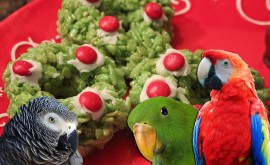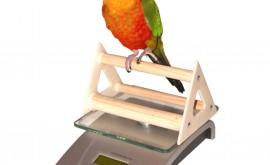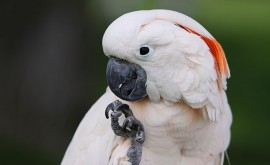Prepare your conure’s home before bringing him back home. Get the right size of cage. Conures need big cages and many toys. Intelligent and constantly busy, you’ll need a large cage so that he can spread his wings without touching the sides of the cage. His tail should not touch the cage bottom or brush the cage top when standing in it. While a cage measuring around 2 x 2 x 3 feet (60 x 60 x 90cm) is the minimum, bear in mind the basic rules of thumb that “bigger is always better” and “one size larger than the pet store recommends”. Choose a cage with some horizontal bars in it, to allow for climbing exercise. Be sure that the cage tray is easy to move in and out, as you will be changing it daily; using a cage apron is also a good idea as it minimizes the mess you have to clean up each day. The base of the cage should have a grille to catch debris such as seeds and feces and keep these away from your bird for good health. Fill the cage with enrichment opportunities. Conures are inquisitive, intelligent birds and need to be kept entertained, so be sure to add some sturdy toys that your conure cannot rip apart. As well, add wooden or rope perches and some toys that can be ripped apart and disposed of. Mirrored toys are much enjoyed by many conures but be careful as mirror toys can create behavioral problems in some birds; use it in moderation.
- Add essentials such as a feeding bowl (stainless steel), seed guard, water container, etc.
- Rotate toys regularly to introduce novelty and to reduce the chances of boredom.
- Safe toys include ones made from untreated wood and rope toys (just be sure that the rope cannot fray; if it does, remove frayed edges to prevent the nails from catching on it). Avoid any toys that are brittle or easily broken. Anything that can catch on beaks, tongues, or toenails should also be avoided.
- Provide perches at different heights to make it more interesting.
- Inspect cages with coated bars carefully. Any chips or holes in the coating can encourage your conure to nibble at them and cause the finish to deteriorate or might even ingest the materials. Make sure the cage is in excellent condition.
- If the cage is galvanized, wash it down with vinegar and water and scrub with a wire brush to remove any loose parts of galvanized wire, then rinse thoroughly and dry completely before adding the bird. These bits of wire can be ingested by the conure, leaving him sick.
- Do not choose a bamboo or wooden cage. The conure will chew on it until he’s out of it!
- Check the cage door to ensure that it opens easily for you but is secure enough to keep the conure inside. Conures can learn to undo doors to their cage, and if this happens, you might need to include a padlock!
- Get a cage cover for nighttime.
Be prepared for the noise. Conures can be very, very loud. Generally the Aratinga Conures (such as the Sun Conure and Jenday Conure) are louder and have more mischievous personalities than the Pyrrhura Conures (such as the Green-cheeked Conure), and have fancier plumage, but Pyrrhura Conures can hold their own, too. Whatever type of conure you choose to own, you’ll be dealing with screaming, especially early in the morning and at dusk. Remember to get that cage cover! Give your conure plenty of attention! Take him out of his cage every day, and take him out whenever you plan on doing something for a long period of time, like working on the computer, making something, or watching TV. If you purchase a birdy harness, you can also safely take him outside for errands or trips to the vet.
- Have fun introducing new toys to your conure. Naturally curious, you’ll be treated to observing the interest and investigation of the conure as he gets to know his new toys. Occasionally though, it might take a few days for it to be familiar enough – in this case, just leave it near the cage for observation and introduce the new object gradually. Also, be sure to teach your conure how to keep himself entertained to prevent boredom; you can’t be with him all day, so he needs to know how to take care of his play needs alone too. If he doesn’t learn this, he might start bad habits such as constant screaming or chewing.
- Purchase a playgym made especially for birds. This can be used with your conure outside of the cage to keep him entertained. This should be placed where people are about so he can be watched and can feel a part of the family.
- Play games with your conure. Try hiding objects underneath a paper cup or similar item and have the bird guess where the hidden item is. You’ll be as absorbed as your pet in this game. Knot up a rope and see how it takes him to guess how to unknot the rope. Place a towel over him gently and see how long it takes him to work his way out. Play tug-of-war with him using an empty paper towel roll; you hold one end, he’ll hold the other, and… tug!




